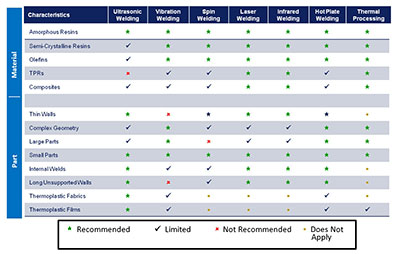Use a Process-Neutral Approach when Selecting an Assembly Method
by Jeffrey Frantz
Branson
When it comes to deciding the best assembly process for an application, the options can be confusing. From mechanical fasteners and adhesives to heat and friction methods, each comes with distinct advantages. To ultimately make the proper choice, every application must stand on its own.
Using a process-neutral approach to determine joining method
All Branson application engineers use a “process-neutral” approach when determining the proper joining technology. What is meant by this is that each application has its own particular properties, characteristics and requirements.
To begin selecting the proper assembly process, it is imperative to define and list all of the properties, characteristics and requirements of the project. This includes component material (do not exclude internal components, if there are any), part geometry and end user requirements.
Three main categories are used in the assembly of plastic components: mechanical, adhesive and welding. Friction and heat methods typically are utilized when materials are compatible (see chart A) and a permanent or tamper-proof seal is needed. These methods, which will be detailed below, do not use consumables. Therefore, the only cost incurred is the initial capital equipment investment and the cost of electricity to run them.
Four Steps to Process Selection
When considering all of the options available, it can be difficult to determine which process is best for an application. These four steps should work for a majority of applications.
The first consideration is material. As seen in the chart below (Chart A), some materials are more readily compatible with a given process. For instance, olefins are somewhat limited in ultrasonic welding, but are recommended for all of the other processes. Ultrasonic welding is not recommended for TPRs and has limited capabilities in some processes, but is recommended for others. Please keep in mind that all aspects of this chart are recommendations gathered through years of experience. “Limited” does not mean excellent results cannot be achieved. The chart is only a guideline.
The next consideration is the part geometry. Begin with the size of the part. One of the limitations of ultrasonic welding is the size of tooling: The lower the frequency (15kHz), the larger the tool (approximate maximum of 10x10") and the higher the frequency (40 kHz), the smaller the tool (approximate size of 2.5x2.5"). If the parts are larger that these ranges, assembly either will require multiple hits with ultrasonics or the choice of another process.
Also in the part geometry category is the complexity of the part and weld profile. Some of the processes can accommodate for these features easily and others cannot.
Wall thickness and internal walls also must be considered. Due to its linear reciprocating motion, vibration welding is difficult when welding long, unsupported walls, while other technologies do not have an issue with these part features.
Do not overlook production volumes. Some assembly options – such as ultrasonic, spin and laser welding – will process assemblies in seconds (or faster), while hot plate welding may take 40 to 50 seconds. In some instances, multiple parts can be welded in a single cycle to improve throughput.
Although it may be difficult, capital equipment cost should be the last consideration. A process selected on price may have long-term processing costs that initially are not considered, such as scrap, downtime and mold changes.
Selecting the best process for an application requires decision-making with an open mind and a “process neutral” perspective. Understand the advantages and limitations of each process available, and work closely with equipment/solution providers to develop a solution that works for the application.

